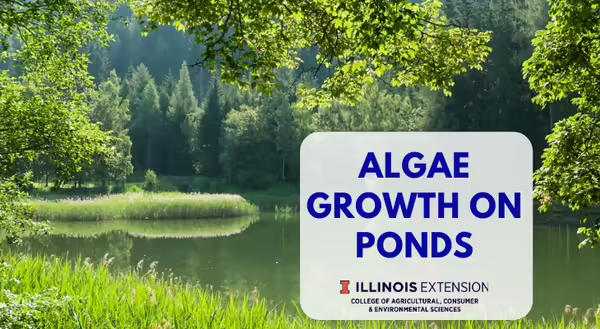
Algae are simple aquatic plants that we often find growing in bodies of water throughout Illinois. We often associate algae with a slimy feeling that makes our ponds and lakes less attractive; it gets stuck on our fishing poles, and it makes swimming less enjoyable. Although algae often get a negative rep, it does produce more than 50% of oxygen in our atmosphere. However, like most things, algae are beneficial under the right circumstances. Excessive algae growth can cause taste and odor problems with drinking water and can even kill fish by limiting oxygen and food.
Algae problems occur when an overabundance of nutrients (nitrogen and phosphorus) enter the pond. These nutrients are often from runoff of fertilized lawns, fields, pastures, feedlots, septic tanks, and leach fields. Older ponds tend to have a buildup of nutrients which can make it more susceptible to algae issues.
To prevent algae problems from happening, it is best to plan to control the issue before it becomes a problem. Methods to prevent algae problems include reducing the amount of nutrients entering your pond by avoiding fertilizer applications around the pond. If you are surrounded by fields or pasture, it is suggested to establish a buffer strip (at least 100 ft) of grass and trees around the edge of the pond. Another option includes water diversion terraces to direct runoff from surrounding fields away from the pond.
If algae growth has already become a problem in a pond, there are still options for control. One method is using fish to eat the algae. Two fish that are used for this are Mozambique Tilapia and Triploid Grass Carp. The tilapia must be restocked every year as they don’t survive at temperatures below 55F, and the grass carp will eat other food in the pond before eating the algae, so these may not be reliable sources of getting rid of the problem.
Another method is chemical control. This requires a bit more work due to improper application resulting in dead fish. Two options for chemicals are copper sulfate and chelated copper; both should be applied in an aqueous form. The pelletized form of copper sulfate is less expensive, but it would first need to be dissolved in water before applying; otherwise it will sink to the bottom of the pond/lake. A water test should be taken before the chemical application is made; in hard water or alkaline water, the treatments are ineffective as the product binds with calcium in the water. The copper sulfate is not effective in cold water while the chelated copper is more effective at low water temperatures. The chelated copper stays in solution and releases copper over a period which would help control the algae longer. Copper is a contact algaecide meaning that the algaecide will only kill what it comes in contact with, so when making a spray application in is necessary to get good spray coverage. As always, it is necessary to follow the recommended rate of the chemical label.
Physical control is another option; however, very laborious. There are rakes and screens to remove the algae. It is also an option to dye the pond/lake to prevent the algae from photosynthesizing and growing. Aeration is another option that increases oxygen levels at the bottom of the pond/lake which increases aerobic bacteria that feed on organic matter and reduce the amount of nutrients in the pond.
Before applying treatment to ponds, it is a good idea to think about how water from the pond will be used. Chemical treatments require a waiting period for swimming, irrigation, watering livestock, etc. For additional information or assistance with pond algae problems, contact your local Extension educator.
Want to get notified when new Good Growing posts are available? SIGN UP HERE!